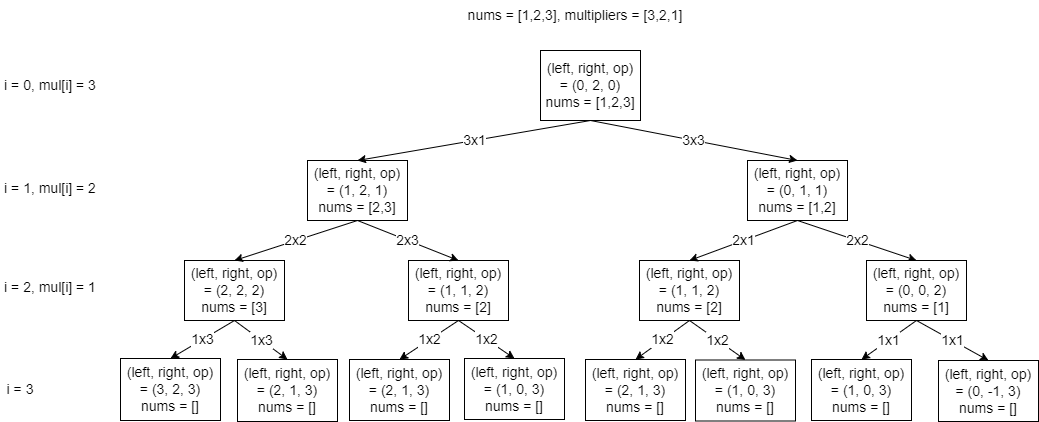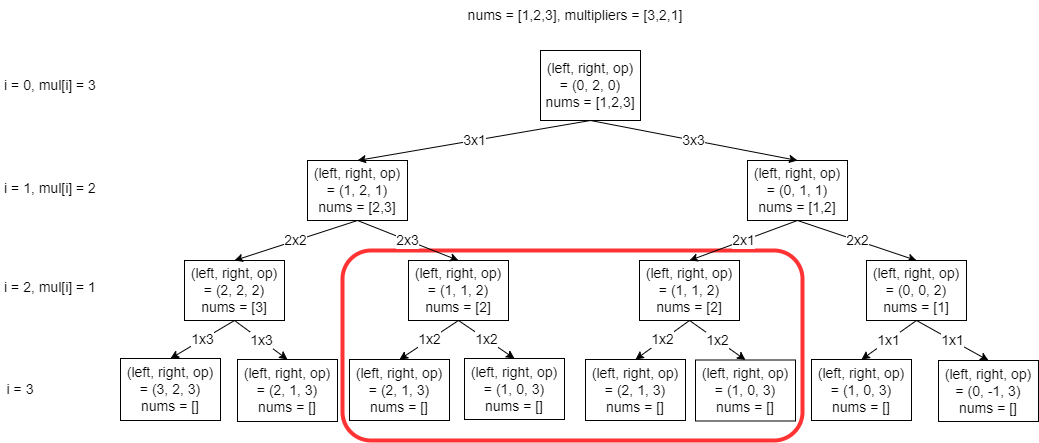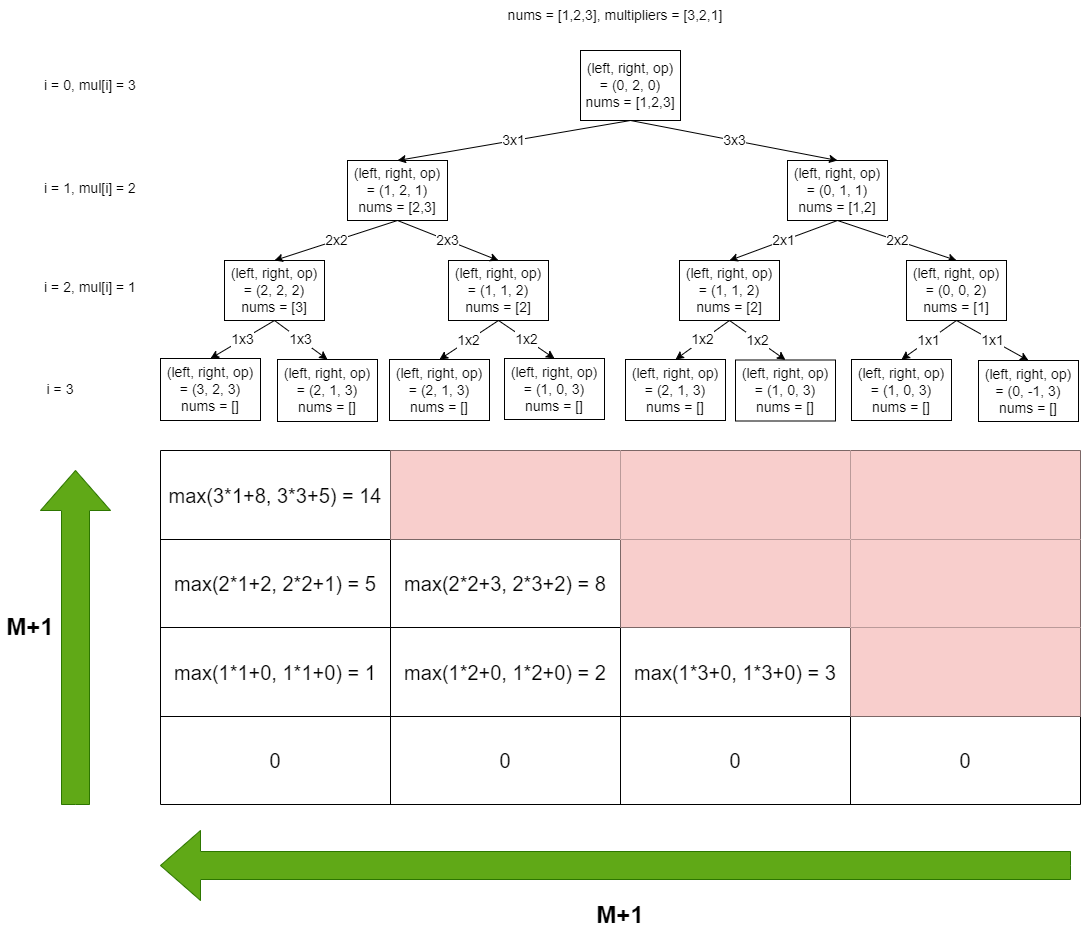Maximum Score from Performing Multiplication Operations
Problem
We are given two array of integers nums and multipliers of size n and m respectively, where n >= m.
Begin with a score of 0, we want to perform exactly m operations. On the ith operation, we will:
- Choose an integer
xfrom either the start or the end of the arraynums. - Add
multipliers[i] * xto your score. - Remove
xfrom the arraynums.
Our task is to find the maximum score after performing m operations.
For example,
Input: nums = [1,2,3], multipliers = [3,2,1] Output: 14 Explanation: The optimal solution is as follows: - Choose from the end, [1,2,3], adding 3 * 3 = 9 to the score. - Choose from the end, [1,2], adding 2 * 2 = 4 to the score. - Choose from the end, [1], adding 1 * 1 = 1 to the score. The total score is 9 + 4 + 1 = 14.
Input: nums = [-5,-3,-3,-2,7,1], multipliers = [-10,-5,3,4,6] Output: 102 Explanation: The optimal solution is as follows: - Choose from the start, [-5,-3,-3,-2,7,1], adding -5 * -10 = 50 to the score. - Choose from the start, [-3,-3,-2,7,1], adding -3 * -5 = 15 to the score. - Choose from the start, [-3,-2,7,1], adding -3 * 3 = -9 to the score. - Choose from the end, [-2,7,1], adding 1 * 4 = 4 to the score. - Choose from the end, [-2,7], adding 7 * 6 = 42 to the score. The total score is 50 + 15 - 9 + 4 + 42 = 102.
Solution
Brute Force
Based on problem description, at every ith operation we have two choices of multiplication which are multipliers[i] * nums[left] and multipliers[i] * nums[right]. Each of the result will then be added to the multiplication of the rest of multipliers with either nums[left+1] or nums[right-1], hence the subproblems.
The subproblem, also called a state, indicates that we can use recursion to solve the problem. Each state is represented by:
leftto indicate the left index to multiply byrightto indicate the right index to multiply byopto indicate the number of the rest of operation
We could generate all possible states as follows:

The algorithm is as follows:
- Create an overload method of
MaximumScorethat takes three arguments: left, right and op - If
opequals the length ofmultiplierswhich means we are done with all the operations, then it will return 0 - Otherwise,
- Multiply
multipliers[op]withnums[left]. Then, solve the subproblem for the next operationop+1with arraynumsrange fromleft+1toright. Add the result of the subproblem to the multiplication. - Multiply
multipliers[op]withnums[right]. Then, solve the subproblem for the next operationop+1with arraynumsrange fromlefttoright-1. Add the result of the subproblem to the multiplication.
- Multiply
- Return the maximum of the two results
- Create the initial call which means we have done
0operation so far with arraynumsrange from0tonums.Length - 1
public int MaximumScore(int[] nums, int[] multipliers)
{
return MaximumScore(0, nums.Length - 1, 0);
int MaximumScore(int left, int right, int op)
{
if (op == multipliers.Length)
return 0;
return Math.Max(multipliers[op] * nums[left] + MaximumScore(left + 1, right, op + 1),
multipliers[op] * nums[right] + MaximumScore(left, right - 1, op + 1));
}
}
Complexity Analysis
Suppose M is the length of multipliers which is the same with the number of operations.
- Time Complexity: At each step we generate two subtree and the height of the tree is
M. The total number of generated nodes is 2M. Since, we traverse all the nodes, then the complexity will be O(2M). - Space Complexity: The complexity will be the same with O(recursion depth), thus it will be O(M).
Top-down Dynamic Programming
Top-down Dynamic Programming approach can be viewed as the improvement of Brute Force approach. We can see from below image that there are some repeated states. These states should be memoized.

To formalize dynamic programming solution, we need to combine three things:
- A function or data structure that answers the problem for a given state
The function isMaximumScore(left, right, op)that denotes the maximum score we get after doingopoperations onnumsarray ranges fromlefttoright. - A recurrence relation that defines transition between states
MaximumScore(left, right, op) = Max(
multipliers[op] * nums[left] + MaximumScore(left + 1, right, op + 1), multipliers[op] * nums[right] + MaximumScore(left, right - 1, op + 1)
) - Base cases
MaximumScore(*, *, op) = 0whenopequals length ofmultipliers.
By memoizing the visited state, we can reduce the complexity.
public int MaximumScore(int[] nums, int[] multipliers)
{
Dictionary<(int, int, int), int> memo = new Dictionary<(int, int, int), int>();
return MaximumScore(0, nums.Length - 1, 0);
int MaximumScore(int left, int right, int op)
{
if (op == multipliers.Length)
return 0;
if (!memo.TryGetValue((left, right, op), out var result))
{
result = Math.Max(multipliers[op] * nums[left] + MaximumScore(left + 1, right, op + 1),
multipliers[op] * nums[right] + MaximumScore(left, right - 1, op + 1));
memo.Add((left, right, op), result);
}
return result;
}
}
Complexity Analysis
Suppose M is the length of multipliers which is the same with the number of operations.
- Time Complexity: By memoizing the state, it will reduce the number of recursion call to the subproblems from 2M to at most M2 because at each state we have two calls that must be performed. Therefore, the complexity will be O(M2).
- Space Complexity: The
memowill store at most M2 number of state, thus the complexity will be O(M2).
Bottom-up Dynamic Programming
Converting top-down to bottom-up technique is not straightforward. However, the rule of thumb is to use table or tabulation.
We can construct a table M+1 * M+1 where M is the length of multipliers. We use M+1 because we need placeholder to avoid IndexOutOfBoundsException.
Based on recursion tree in top-down approach, we work bottom up and compress the tree from the bottom in such way that it will fill only half of the table we provide.

public int MaximumScore(int[] nums, int[] multipliers)
{
int m = multipliers.Length;
int n = nums.Length;
int[,] dp = new int[m + 1, m + 1];
for (int op = m - 1; op >= 0; op--)
{
for (int left = op; left >= 0; left--)
{
int right = n - 1 - (op - left);
dp[op, left] = Math.Max(multipliers[op] * nums[left] + dp[op + 1, left + 1],
multipliers[op] * nums[right] + dp[op + 1, left]);
}
}
return dp[0, 0];
}
Complexity Analysis
Suppose M is the length of multipliers.
- Time Complexity: Since the total of iteration is half of the matrix or M2/2, then the complexity is O(M2).
- Space Complexity:
dparray has size (M+1)2, thus the complexity is O(M2).